Diocese of Fortuna islands and Diocese of Rubicon
In 1351, Pope Clement VI issued the bull "Coelestis rex regum", which established the diocese of the Islas de la Fortuna, separating it from the diocese of Majorca. In 1369 Pope Urban V issued a bull renaming it the Diocese of Telde, extending its jurisdiction to the island of Gran Canaria. In 1441 this diocese was abolished. [3]
On July 7, 1404, Pope Benedict XIII issued the bull "Romanus Pontifex", which established the Diocese of Rubicon, which extended its jurisdiction to the island of Lanzarote. [4] On November 20, 1424, the Diocese of Rubicón ceded part of its territory for the construction of the Diocese of Fuerteventura, which was dissolved in 1433, its territory passing into the hands of the Diocese of Rubicón.
Diocese of the Canary Islands
On August 25, 1435, Pope Eugene IV issued a decree transferring the seat of the Diocese of Rubicon to the city of Las Palmas de Gran Canaria. In 1485, the Diocese of Rubicon was renamed the Diocese of the Canary Islands and Rubicon.
The first two native saints of the Canary Islands, Joseph of Anchieta (1534-1597) and Peter of Betancur (1626-1667), although of Tenerife origin, were born in this diocese when it still included the entire archipelago. [5] Considered the two most important religious figures that the Canary Islands have given, they carried out great missionary and apostolic work on the American continent.
In 1630, the Diocese of the Canary Islands ceded part of its territory to form the Apostolic Prefecture of Tripoli (today the Apostolic Vicariate of Tripoli).
In 1787, 746 diocesan priests were registered, including secular and regular clergy. At the end of the 18th century, the diocese comprised 36 parishes with benefices, whose parish priests were appointed by the king, and 50 "cural" parishes, whose parish priests were appointed by the bishops and received a salary from the diocesan curia. The majority of the parishes were located on the island of Tenerife, with 16 charitable parishes and 22 curacies. [6] The religious subdivision into parishes was used, at the beginning of the 19th century, for the administrative subdivision of the Canary Islands. [7]
On February 1, 1819 and August 10, 1838, the Diocese of the Canary Islands ceded part of its territory for the construction of the new Diocese of San Cristóbal de la Laguna and the Diocese of Algiers (today the Archdiocese of Algeria). There are currently two dioceses in the Canary Islands, one of which, "Diocese of the Canary Islands", for this reason, the use of the name of the archipelago is currently a very controversial topic in the Canary Islands. [8] [9]
It has recently emerged between the society of Lanzarote the desire to recover the diocesan headquarters of Rubicon. [10] [11]


